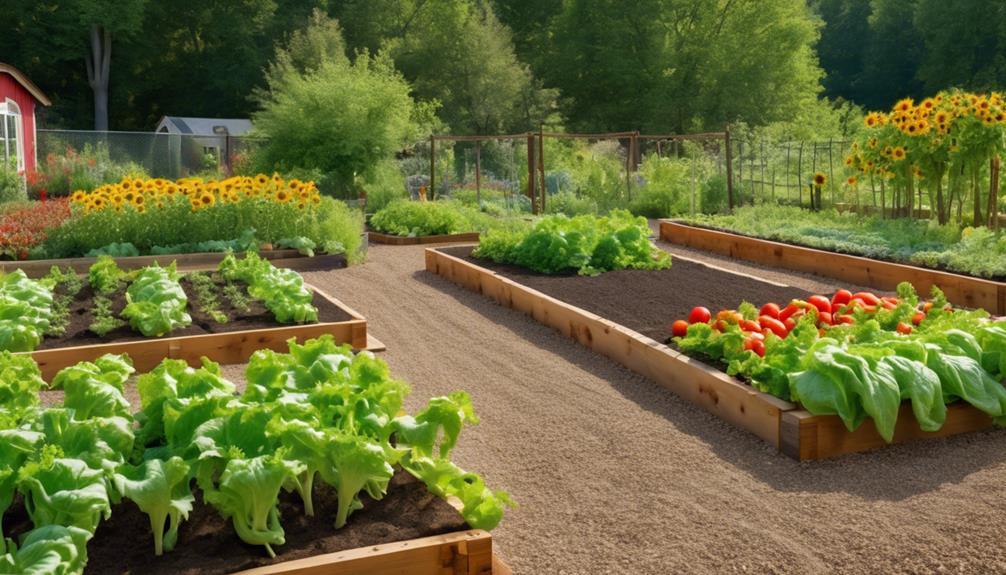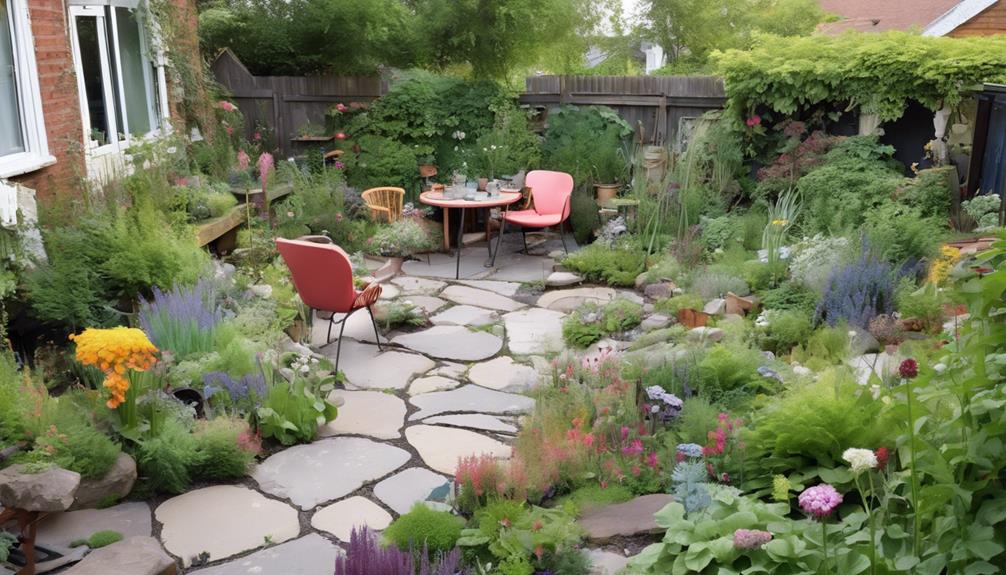
Top Modern Garden Design Trends
12 September 2024
Maximize Your Garden With Expert Design Insights
13 September 2024Creating an effective vegetable garden layout involves utilising space wisely and promoting healthy plant interactions.
Begin by employing vertical gardening techniques to optimise light and space. Companion planting not only enhances pest control but also improves crop yields through beneficial relationships.
Ensure proper plant spacing to prevent overcrowding and disease. Regular soil assessments help maintain nutrient and pH levels critical for growth.
Integrating pathways facilitates access while keeping growing areas intact. To further refine your garden design, consider tools and expert services that can assist in enhancing your setup and productivity for a fruitful gardening experience.
Garden Layout Essentials
Effective garden layout is pivotal for maximising space and promoting healthy plant growth.
By employing space utilisation strategies, gardeners can optimise their plots to boost productivity.
Furthermore, understanding the benefits of companion planting can lead to improved pest management and increased crop yields.
Space Utilization Strategies
While designing a vegetable garden, optimising space utilisation is crucial for ensuring a productive and efficient growing environment.
Employing vertical gardening techniques, such as trellising and wall planters, allows for the cultivation of climbing plants while saving horizontal space.
Moreover, consider implementing raised beds, which not only improve drainage but also enable you to plant intensively.
Adopting a staggered planting schedule can increase yield by utilising space throughout the growing season.
In addition, integrating pathways strategically can facilitate access to plants without compromising growing areas.
Ultimately, utilising intercropping—growing complementary crops together—can enhance biodiversity and reduce competition for resources, leading to a more robust garden ecosystem.
Each of these strategies contributes to ideal space utilisation in vegetable gardening.
Companion Planting Benefits
Companion planting, a strategic approach to garden layout, involves pairing specific plants to improve growth, deter pests, and optimise space.
This method capitalises on the natural relationships between plants, augmenting their individual strengths and mitigating weaknesses. For instance, planting marigolds alongside vegetables can repel nematodes and aphids, while basil can enhance the growth and flavour of tomatoes.
Furthermore, certain plants can provide necessary shade or support for others, creating a micro-ecosystem that fosters resilience and productivity.
By understanding and implementing companion planting, gardeners can achieve a more balanced and sustainable garden.
Ultimately, this practice not only increases yield but also contributes to an ecologically sound gardening approach, reducing the need for chemical interventions.
Plant Spacing Considerations
Effective plant spacing is essential for maximising the health and productivity of your vegetable garden.
Key factors to take into account include evaluating soil quality, understanding the benefits of companion planting, and ensuring adequate sunlight exposure for each plant.
Soil Quality Assessment
Evaluating soil quality is essential for determining the ideal plant spacing in your vegetable garden.
Healthy soil promotes robust plant development, allowing each vegetable to thrive without competing for vital nutrients, water, and light.
Here are three key factors to assess:
- Nutrient Density: Analyse the macronutrients (nitrogen, phosphorus, potassium) and micronutrients present to ensure balanced growth.
- Soil Texture: Determine the proportions of sand, silt, and clay, as these influence drainage, aeration, and root penetration.
- pH Level: Test the soil's acidity or alkalinity; most vegetables prefer a pH range of 6.0 to 7.5 for optimal nutrient availability.
Companion Planting Benefits
In vegetable gardening, the strategic pairing of plants can yield significant benefits, enhancing growth and maximising space efficiency.
By implementing companion planting, gardeners can create synergistic relationships that lead to healthier crops and improved yields.
Consider the following advantages:
- Pest Control: Certain plants, such as marigolds, repel harmful insects that threaten adjacent crops, reducing the need for chemical pesticides.
- Nutrient Sharing: Deep-rooted plants, like tomatoes, can draw nutrients from deeper layers of soil, while shallow-rooted companions, such as lettuce, utilise upper soil nutrients, optimising resource use.
- Enhanced Pollination: Planting flowering companions attracts beneficial pollinators, improving fruit set and overall productivity.
Sunlight Exposure Requirements
Companion planting not only enhances plant relationships but also requires careful consideration of sunlight exposure requirements to optimise growth potential.
Understanding the light needs of each vegetable is essential for maximising yield and health.
Here are three key considerations for effective plant spacing based on sunlight exposure:
- Tall Plants: Position taller crops, such as tomatoes or sweetcorn, on the northern side to prevent shading shorter plants.
- Sunlight Intensity: Group sun-loving vegetables like peppers and cucumbers together, ensuring they receive at least six hours of direct sunlight each day.
- Shade Tolerance: Plant shade-tolerant varieties, such as lettuce or spinach, in areas that receive indirect light, optimising space without compromising growth.
Garden Design Software Tools
Garden design software tools can significantly enhance your planning process by enabling you to visualise your garden's layout.
These tools assist you in selecting the ideal location for your garden, implementing effective mulch strategies for moisture retention, and exploring vertical gardening techniques to optimise space.
Choose Your Garden Location
Choosing the right location for your vegetable garden is crucial for ensuring ideal growth and productivity. A well-chosen site not only optimises sunlight exposure but also improves soil quality and drainage.
Consider these key factors when determining your garden's location:
- Sunlight: Aim for a spot that receives at least 6-8 hours of direct sunlight daily, as most vegetables thrive in bright conditions.
- Accessibility: Choose a location that is easily reachable for regular maintenance, watering, and harvesting, minimising physical strain.
- Drainage: Identify areas with well-draining soil to prevent waterlogging, which can impede root health and foster disease.
Mulch to Retain Moisture
Effective mulching is a crucial practice for retaining moisture in vegetable gardens, greatly enhancing plant health and yield.
By creating a protective barrier, mulch minimises evaporation and regulates soil temperature, fostering a more conducive environment for root development.
To optimise the benefits of mulching, consider the following:
- Organic Materials: Use straw, wood chips, or shredded leaves to promote beneficial microbial activity while enriching the soil as they decompose.
- Inorganic Options: Apply landscape fabric or gravel to provide long-lasting coverage, particularly in pathways, reducing weed growth and conserving moisture.
- Thickness: Aim for a mulch layer of 5-10 centimetres to effectively suppress weeds and retain moisture without suffocating the plants.
Incorporating these techniques will enhance your gardening expertise and results.
Vertical Gardening Strategies
Vertical gardening strategies are increasingly popular among gardeners seeking to maximise space and improve aesthetic appeal.
By implementing creative designs, one can cultivate a flourishing garden even in limited areas. Here are three effective strategies:
- Trellises: Utilise sturdy trellises for climbing plants such as cucumbers and tomatoes, allowing them to grow upwards and receive ample sunlight.
- Wall Planters: Incorporate wall-mounted planters filled with herbs or salad greens, creating a striking vertical display while saving ground space.
- Hanging Baskets: Suspend hanging baskets from hooks or beams, which are ideal for strawberries or trailing plants, enhancing your garden's visual dynamics.
Employing these strategies not only optimises your gardening space but also enhances the overall aesthetic, resulting in a vibrant and productive vegetable garden.
Pest Control Through Diversity
In the realm of sustainable agriculture, fostering biodiversity within your vegetable garden can serve as a powerful strategy for pest control. By incorporating a variety of plants, you create a balanced ecosystem that naturally deters pests. Different species attract beneficial insects, such as pollinators and predatory insects, which prey on harmful pests.
| Plant Type | Pest Deterrent Effect |
|---|---|
| Marigolds | Repel nematodes |
| Basil | Deters flies |
| Nasturtiums | Attract aphid predators |
| Garlic | Repels a variety of pests |
Embracing such diversity not only improves pest resistance but also enhances soil health and yields, fostering a resilient garden environment.
Garden Design Consultation Services
Garden design consultation services can significantly enhance the success of your vegetable garden by offering bespoke recommendations on soil amendments and organic fertilisers.
These experts can also advise you on the optimal timing and frequency for fertilisation to ensure your plants thrive.
Soil Amendment Recommendations
Improving soil quality is crucial for a thriving vegetable garden, and thoughtful soil amendments can significantly enhance plant health and productivity.
To cultivate a robust garden, consider the following amendments:
- Compost: Rich in nutrients and beneficial microorganisms, compost improves soil structure, promotes drainage, and boosts moisture retention.
- Peat Moss: This organic material increases aeration and moisture retention, creating an ideal environment for root development while also slightly acidifying the soil.
- Granular Lime: Vital for balancing soil pH, granular lime can rectify acidic conditions, ensuring that essential nutrients are available for plant uptake.
Incorporating these amendments will create a fertile foundation for your vegetables, leading to a bountiful harvest.
Mastering soil amendment techniques will greatly influence your gardening success.
Organic Fertilizer Recommendations
To achieve ideal growth and yield in your vegetable garden, selecting the right organic fertilisers is vital.
These fertilisers not only nourish your plants but also improve soil health, promoting biodiversity.
Here are three highly effective organic fertiliser options to consider:
- Compost: Rich in nutrients and beneficial microorganisms, compost enhances soil structure and fertility while retaining moisture.
- Bone Meal: A slow-release source of phosphorus, bone meal encourages strong root development and flowering, fundamental for fruiting vegetables.
- Fish Emulsion: Packed with nitrogen, fish emulsion stimulates vigorous foliage growth and is easily absorbed by plants, making it ideal for leafy greens.
Incorporating these organic fertilisers will greatly boost the productivity and health of your vegetable garden.
Fertilizer Timing and Frequency
Effective management of fertiliser timing and frequency is crucial for maximising the health and yield of your vegetable garden. A well-timed fertilisation schedule guarantees that nutrients are available when your plants need them most, promoting vigorous growth and fruit production.
Consider the following guidelines:
- Pre-Planting: Apply a balanced fertiliser before planting to enrich the soil, enhancing its nutrient profile.
- Mid-Season Enhancement: Reassess plant health around mid-season, applying a side-dressing of fertiliser to support ongoing growth, especially for heavy feeders like tomatoes and peppers.
- Post-Harvest Care: After harvesting, incorporate compost or slow-release fertilisers to replenish soil nutrients and prepare for subsequent planting cycles.
Adhering to these practices will enhance your gardening expertise and ensure a bountiful harvest.
Watering Frequency Adjustments
Adjusting watering frequency is crucial for optimising plant health and yield in your vegetable garden.
Understanding soil pH, implementing companion planting strategies, and utilising crop rotation can greatly influence water needs and overall garden productivity.
Soil Ph Adjustment Techniques
While many factors influence soil pH, the frequency of watering plays a crucial role in its adjustment. Watering not only delivers moisture but also affects the chemical composition of the soil.
To achieve ideal pH levels, consider the following techniques:
- Consistent Moisture: Maintain a steady watering schedule to prevent drastic pH fluctuations, ensuring your plants receive a balanced nutrient supply.
- Adjust Water Quality: Use rainwater or filtered water to avoid introducing harmful chemicals, which can adversely alter pH levels.
- Incorporate Organic Matter: Regularly amend the soil with organic materials, as they improve moisture retention and gradually alter pH, creating a more favourable environment for plant growth.
Implementing these strategies will enhance your mastery of soil pH management in your vegetable garden.
Companion Planting for Pest Control
Utilising companion planting as a strategy for pest control can significantly enhance the health of your vegetable garden.
By strategically pairing plants, you can create a natural ecosystem that deters pests and improves growth.
Here are three effective companion plant combinations:
- Marigolds and Tomatoes: The scent of marigolds repels nematodes and aphids, protecting tomato plants.
- Basil and Peppers: Basil not only enhances the flavour of peppers but also wards off aphids and spider mites.
- Nasturtiums and Cucumbers: These vibrant flowers attract aphids, diverting them from cucumber plants while also serving as a trap crop.
Crop Rotation Benefits
Crop rotation is a fundamental practice in sustainable gardening that offers numerous benefits, including the optimisation of watering frequency.
By alternating crops, gardeners can improve soil structure and moisture retention, leading to more efficient water use. This practice minimises water stress on plants, ensuring robust growth and productivity.
- Deep-rooted crops such as carrots and beetroot penetrate the soil, creating channels for water infiltration.
- Legumes enrich the soil with nitrogen, reducing the need for synthetic fertilisers and aiding in moisture retention.
- Leafy greens can utilise surface moisture effectively, allowing for reduced watering intervals.
Implementing crop rotation not only conserves water but also fosters a healthier, more resilient garden ecosystem.
Why Choose TKL Birmingham Gardener
Choosing TKL Birmingham Gardener for your vegetable garden needs guarantees a professional approach backed by extensive experience and local expertise.
Our team is dedicated to understanding the unique environmental factors affecting your garden. We utilise proven techniques tailored to your specific soil conditions and climate, ensuring ideal plant health and yield.
Our commitment to sustainable gardening practices not only improves productivity but also promotes ecological balance within your space.
By selecting TKL, you gain access to personalised consultations, meticulous planning, and ongoing support throughout the growing season.
Our emphasis on continuous education equips you with the knowledge necessary for mastery in vegetable gardening.
Trust TKL Birmingham Gardener to transform your garden into a flourishing ecosystem that meets your culinary aspirations.
Common Gardening Mistakes
Even with expert guidance from TKL Birmingham Gardener, common gardening mistakes can still undermine the success of your vegetable garden.
A frequent error is overcrowding plants, which inhibits air circulation and increases susceptibility to disease.
Moreover, neglecting soil health can lead to poor nutrient availability; consequently, regular testing and amendments are essential.
Failure to rotate crops annually can deplete soil nutrients and foster pest infestations.
Many gardeners also overlook the importance of proper watering techniques, leading to either waterlogged roots or drought stress.
Finally, planting without considering sunlight requirements can stunt growth and reduce yields.
Final Garden Assessment Tips
As the growing season comes to a close, it's essential to wrap up your gardening efforts with a thorough final assessment. This evaluation not only enhances your skills but also prepares you for future planting seasons.
Here are three critical steps to reflect on during your assessment:
- Soil Health Evaluation: Test your soil for pH and nutrient content, identifying areas that may require amendments or crop rotation.
- Plant Performance Review: Analyse which vegetables thrived and which struggled, taking note of the conditions that contributed to their success or failure.
- Pest and Disease Inspection: Check for any lingering pests or diseases, ensuring you address them before the off-season to protect future crops.




